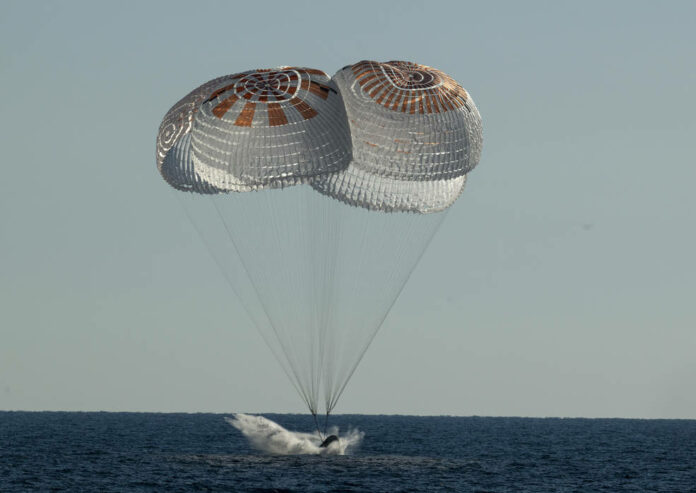KENNEDY SPACE CENTER, Fla. — NASA’s SpaceX Crew-4 splashed down Friday off the coast of Jacksonville, Fla., completing the agency’s fourth commercial crew mission to the International Space Station. The international crew of four spent 170 days in orbit.
NASA astronauts Bob Hines, Kjell Lindgren, and Jessica Watkins and ESA (European Space Agency) astronaut Samantha Cristoforetti returned to Earth in a parachute-assisted splashdown at 4:55 p.m. EDT.
Teams aboard SpaceX recovery vessels retrieved the spacecraft astronauts aboard the Dragon spacecraft. The astronauts flew to NASA’s Johnson Space Center in Houston. Cristoforetti then boarded a plane to Europe.
“Welcome home Crew-4! This international crew has spent nearly six months on the International Space Station conducting science for the benefit of all. Their work aboard the orbiting laboratory will help prepare future explorers for future space missions,” said NASA Administrator Bill Nelson. “Working and living on the space station is the opportunity of a lifetime, but it also requires these explorers to make sacrifices, especially time away from loved ones.
“Kjell, Bob, Jessica and Samantha, thank you for your contributions over the past six months to science, innovation, and discovery!”
The Crew-4 mission launched at 3:52 a.m. EDT April 27 on a Falcon 9 rocket. Less than 16 hours later, Dragon docked to the Harmony module’s space-facing port. The astronauts undocked from the same port at 12:05 p.m. Friday, to begin the trip home.
Hines, Lindgren, Watkins, and Cristoforetti traveled 72,168,935 miles, spent 170 days aboard the space station, and completed 2,720 orbits around Earth.
Lindgren has logged 311 days in space over his two flights, and with the completion of their flight today, Cristoforetti has logged 369 days in space on her two flights, making her second on the all-time list for most days in space by a woman.
The Crew-4 mission was the first spaceflight for Hines and Watkins.
Cristoforetti completed two spacewalks with Roscosmos cosmonaut Oleg Artemyev to perform station maintenance and upgrades.
Crew-4 continued work on investigations documenting how improvements to the space diet affect immune function and the gut microbiome, determining the effect of fuel temperature on the flammability of a material, exploring possible adverse effects on astronaut hearing from equipment noise and microgravity, and studying whether additives increase or decrease the stability of emulsions.
The astronauts also investigated microgravity-induced changes in the human immune system similar to aging, tested a novel water-reclamation membrane, and examined a concrete alternative made with a material found in lunar and Martian dust.
Don’t miss out! Subscribe to our email newsletter to have all our smart stories delivered to your inbox.



